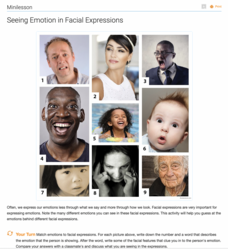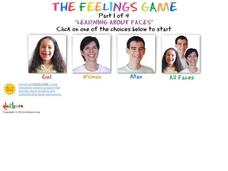Thoughtful Learning
Seeing Emotion in Facial Expressions
Learning to read body language, especially facial expressions, is the focus of a mini-lesson. Young learners examine a series of photographs, identify the emotion being illustrated, and then discuss the cues that revealed the emotion.
Lions Clubs International Foundation
Mindful Self-Awareness Exercise: Identifying Feelings
Following a breathing exercise, scholars examine facial expressions and body posture to identify feelings. The exercise ends with a reflection.
Learning for Justice
What is Empathy?
Young scholars examine facial expressions to identify emotions, listen carefully to stories, and choose the appropriate reaction. Partners choose one story to rewrite, showing empathy for others.
Health Smart Virginia
How Are You Feeling Today?
A presentation guides a thoughtful discussion about identifying emotions. Slide-by-slide, scholars answer questions and offer details about specific feelings. A worksheet challenges class members to draw facial expressions and describe...
Nemours KidsHealth
Feelings: Grades K-2
Learners explore how to appropriately deal with their feelings. In this personal health activity on feelings, students participate in a group discussion about feelings, and complete two activities writing about their feelings and...
Missouri Department of Elementary
Feeling Faces
A instructional activity help scholars identify emotions through facial expressions. After a friendly puppet reads scholars a poem all about feelings, learners act out how they would feel when a specific action happens to them....
Lions Clubs International Foundation
Mindful Self-Awareness Exercise: Identifying Feelings
A self-awareness activity teaches pupils to identify their feelings by focusing on different parts of their bodies. Participants begin by focusing attention on their feet, then calves, moving up slowly to the top of their head, and...
Lions Clubs International Foundation
Mindful Self-Awareness Exercise: Identifying Feelings
Young scholars identify feelings through facial expressions and body language. Learners listen for a feeling word, then act it out and discuss how they portrayed it.
Overcoming Obstacles
Understanding Nonverbal Communication
People communicate in all sorts of ways. As part of a study of nonverbal communication, teams of three must complete a puzzle without speaking to one another. After debriefing the activity and analyzing the messages nonverbal cues...
Northern Ireland Curriculum
Feeling Good, Feeling Sad
Fill your classroom with grand conversations about emotions and the healthy ways to express them. Your scholars will create a collage, play a feelings game, read stories, and reflect on their daily feelings.
Do2Learn
The Feelings Game
Discerning emotions and intent from facial expressions can be difficult for many learners, particular those with autism spectrum disorder. Help class members practice reading faces with an interactive resource that features three...
District 186 Springfield Public Schools
Tone, Mood, Theme, and Motif
It's all well and good when you're asked to identify a speaker's tone using his or her body language, facial expression, and pitch and emphasis. Identifying the tone of a written passage is another challenge entirely. Check out an...
Workforce Solutions
Actions Speak Louder Than Words
A short video demonstrates the importance of non-verbal communication in the forming of first impressions. Viewers observe the facial expressions, tone of voice, body language, and appearance of job seekers in an interview, then discuss...
Missouri Department of Elementary
Happy, Sad, Scared and Mad: All Belong To Me
"What are feelings?" and "Why are feelings important to understand?" are the essential questions of a lesson plan that boosts self-awareness. Scholars discuss the four basic emotions—happy, sad, scared, and mad—in preparation for a...
EngageNY
The Storyteller’s Toolbox and Excerpt 4 First Read
It's story time! Scholars take a look through the eyes of a storyteller as the teacher reads aloud The People Could Fly. They also listen as the story is played on video. Learners then answer questions about the reader's facial...
K20 LEARN
Who Are They Really?: Characterization In The Outsiders
Ponyboy, Johnny, Winston, and Darry come alive in a lesson that focuses on the details S. E. Hinton uses to characterize the Greasers and the Socials. The class first observes the actors' words; the thoughts revealed their effect on...
Centre for Clinical Interventions
Social Skills Treatment Programme
Even though they may not be tested on standardized assessments, social skills are vital for students to develop during their years in school. Through a series of discussions, activities, and role-playing exercises, these lessons teach...
Overcoming Obstacles
Giving and Earning Respect
RESPECT! High schoolers learn what it means, how to earn it, who deserves it, and why in the first of five lessons in this section of the Overcoming Obstacles course. After brainstorming a list of people they think to deserve respect and...
Overcoming Obstacles
Understanding Nonverbal Messages
The Overcoming Obstacles course for middle schoolers continues with a unit module on communication. In the first lesson plan, participants engage in a series of activities that help them recognize nonverbal clues and the importance of...
Anti-Defamation League
Microaggressions In Our Lives
Defining, identifying, and learning how to counter microaggression is the lesson's focus for high schoolers. Learners examine a definition of the term, write about their own experiences with microaggression, watch short video examples,...
National Woman's History Museum
Seneca Falls and Suffrage: Teaching Women's History with Comics
As part of the study of women's history, young scholars examine Chester Comix's strips about the Seneca Falls Convention and four 19th century leaders in the struggle for equal rights. After researching other elements of the Suffrage...
EngageNY
Presenting a Research-Based Claim: Effective Speaking Techniques
Take note. Scholars receive their claim drafts back to revise and write their claims and three pieces of evidence on notecards. They save the notecards to use when the verbally present their claims to the class. At the end, individuals...
English Enhanced Scope and Sequence
Identifying Synonyms
"Let the hunt begin!" As an introduction to synonyms, second graders generate a list of word pairs that have similar meanings. The words pairs are written on sentence strips, cut apart, shuffled, and distributed to class members who must...
PBS
Robot Body Language
Don't be so emotional! Scholars take part in an activity where they consider how future robots will be able to show emotions. They place paper bags over their heads, act out emotions through body movements, and have others guess the...
Other popular searches
- Human Facial Expressions
- Drawing Facial Expressions
- Feeling and Facial Expressions
- Drama Facial Expressions
- Draw Facial Expressions
- Facial Expressions and Lying
- Speech Facial Expressions
- Reading Facial Expressions
- Facial Expressions Art
- Facial Expressions in Art

























